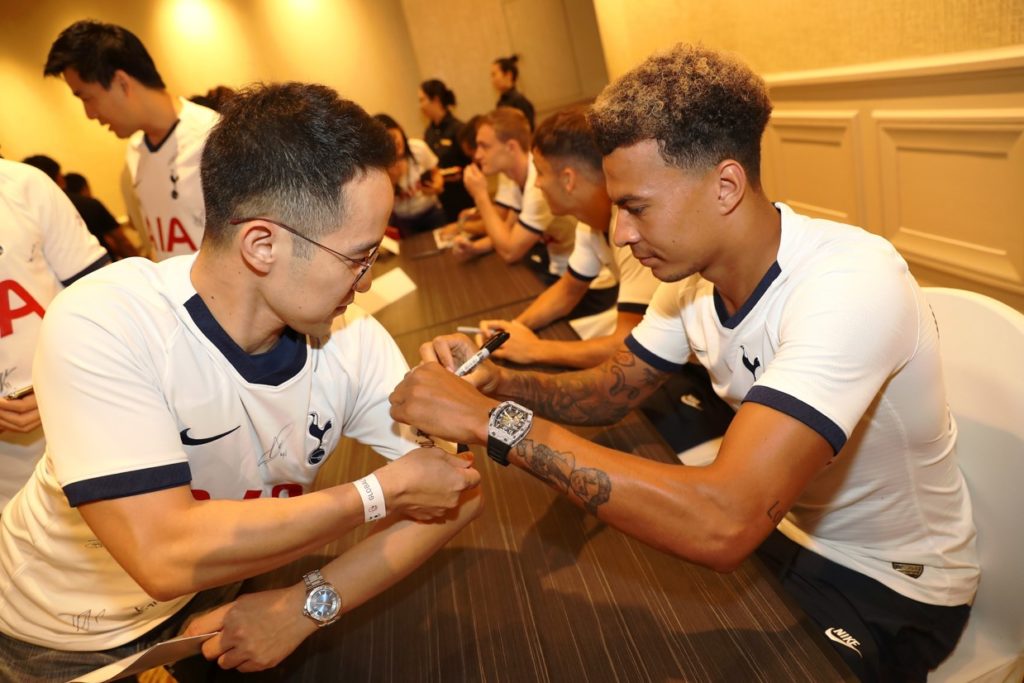How is Asian investment altering the commercial landscape of the English game?
Sixteen years ago, Chinese telecoms company Kejian cast a solitary figure in English Premier League sponsorship, as the only Asian brand to appear on a shirtfront. Fast forward to 2019 and there are eleven front-of-shirt sponsors from the region, with a further seven shirt sleeves bearing the name of an Asian company. All this comes at an aggregated cost of approximately £160m per season. The Asia region is now contributing to 25% of global sponsorship spend and is valued at $65bn annually.
Investment from Asian brands in the Premier League is showing no signs of letting up. At the end of July, Tottenham Hotspur inked a long-term extension of its global principal partnership with life insurers AIA. The deal takes them through to the end of the 2026-27 season and will see the relationship span well over a decade. We’ve taken this opportunity to explore the growing Asian influence on English football’s commercial landscape.
The tyre company who got the party started

We’ve come a long way since it all began in Kettering Town with Kettering Tyres back in 1967. It was the first-of-its-kind partnership between a brand and an English football team. The first domino to topple, with top tier clubs following suit, forming a sponsorship landscape which has grown exponentially since. The planet’s finest players and biggest broadcast deals were next to join the English Premier League party, laying the foundations for one of the most valuable commercial products in the sporting world.
Asian interest is here to stay
The international interest in the Premier League – and the climbing valuations this has brought with it – has long since priced Kettering Tyres out of the equation, along with many larger domestic brands. Out of the twenty clubs lining up in the Premier League this season, only Liverpool have a front-of-shirt sponsor headquartered in the UK (Standard Chartered), although even here the focus is on international business rather than domestic consumers.
As many as eleven teams, meanwhile, boast Asian companies in the prized position, demonstrating that brands from the region continue to recognise the role that partnerships in football can play in helping achieve regional business objectives. Chelsea are a prime example, with an ‘all Asia’ jersey inclusive of a Japanese front-of-shirt sponsor (Yokohama Tyres) and a South Korean shirt sleeve sponsor (Hyundai) – one of six such teams in the Premier League with a full house.
Insurance companies in Asia, in particular, have identified partnerships with Premier League clubs as a vital marketing channel to get cut through. Not only does sponsorship help the brand build a distinct personality and drive greater affinity, it also offers them a channel to communicate their core brand values.
AIA’s sponsorship of Tottenham Hotspur, for instance, has helped the brand reach millions of fans across Asia-Pacific, proving its value in driving awareness and growing consideration. AIA has also embraced a natural synergy between its brand and the club, helping people lead healthier lives through community initiatives.

Additionally, access to money-can’t-buy experiences and exclusive events can incentivise sales teams, boost employee engagement and help drive sales. It is little wonder, therefore, that AXA have also signed a big money deal to become Liverpool FC’s new official training kit partner, whilst Aon continue to partner with Manchester United in an effort to deepen its exposure to the club’s vast fanbase in the region.
This love affair is showing no signs of abating and is beginning to make an indelible, and invaluable, mark on the landscape of English football. One in five Premier Clubs, and one in three in the Championship, now sport Asian ownership.
Recent interest from Asian companies has not been confined to club competitions alone. According to the analytics and insights firm Nielsen Sports’, brands from the APAC region were responsible for 39% of all sponsorship deals at the 2018 FIFA World Cup. (i)
Notably China is honing in on the opportunity with Wanda, Hisense, Vivo and Mengniu among this contingent of Asian sponsors. This interest goes right to the top with President Xi Jinping publicly stating his ambition to host and win the FIFA World Cup by 2050.
Alongside this involvement in the international game, there is a growing attempt to wrestle control from West to East at club level, with investment in the Chinese Super League exploding in recent years. With money seemingly no object, it is enticing global super stars such as Oscar, Paulinho, and Javier Mascherano, along with leading manager, Rafael Benitez. A rumoured £1.2 million per-week deal for Gareth Bale, still in his prime at 29, fell through at the 11th hour, but indicated that this trend is far from a passing fad.
The sustained growth of English football in Asia
The signs that the Premier League had captured the hearts and minds of an Asian audience were there as early as 2003. On New Year’s Day that year, an astonishing 360 million people tuned in to watch Everton take on Man City at Goodison Park – a fact made all the more intriguing given the low-profile of this fixture in the eyes of a UK audience.
The secret ingredient? The presence of Li Tie (Everton) and Sun Jihai (Man City) on the field that day; two of China’s most well-known footballing exports. Billed as the ‘Chinese Derby’, the game set a new record for the most watched Premier League game in history.
Walk the streets of almost any Asian city, town or village now and it won’t take long for you to pass a local wearing the colours of their adopted English team. The popularity of the Premier League remains way out in front of its European neighbours, with a 19% increase in following since 2015 and four of the top six most popular clubs in the region coming from England’s top tier. (ii)
As time has gone on, a greater variety of clubs have begun to gain traction in Asia. Signings of players such as Maya Yoshida and Son Heung-min have helped boost the profile of Southampton and Spurs respectively. The Leicester fan-base, meanwhile, has grown exponentially in Thailand, home to both owner and key sponsor King Power – an expansion dramatically aided by the Foxes’ miraculous Premier League title win in the 2015-16 season. Asian destinations remain a regular occurrence on the pre-season tour schedule too, forming a crucial strategy in increasing club visibility and growth.
The rising popularity of the Premier League in Asia shows little sign of slowing down and the region will continue to be a major player for the foreseeable future. Premier League clubs will continue to look East to capitalise on an extremely engaged audience and further commercialise their brands via strategic partnerships. As long as the appeal of the UK’s greatest cultural export continues to surpass that of domestic competitions in Asia, the need for regional brands to invest in global rather than local teams will endure.
The signs that the
Premier League had captured the hearts and minds of an Asian audience were
there as early as 2003. On New Year’s Day that year, an astonishing 360 million
people tuned in to watch Everton take on Man City at Goodison Park – a fact
made all the more intriguing given the low-profile of this fixture in the eyes
of a UK audience.
The secret ingredient? The presence of Li Tie (Everton) and Sun Jihai (Man
City) on the field that day; two of China’s most well-known footballing
exports. Billed as the ‘Chinese Derby’, the game set a new record for the most
watched Premier League game in history.
Walk the streets of almost any Asian city, town or village now and it won’t
take long for you to pass a local wearing the colours of their adopted English
team. The popularity of the Premier League remains way out in front of its
European neighbours, with a 19% increase in following since 2015 and four of
the top six most popular clubs in the region coming from England’s top
tier. (ii)
As time has gone on, a greater variety of clubs have begun to gain traction in
Asia. Signings of players such as Maya Yoshida and Son Heung-min have helped
boost the profile of Southampton and Spurs respectively. The Leicester
fan-base, meanwhile, has grown exponentially in Thailand, home to both owner
and key sponsor King Power – an expansion dramatically aided by the Foxes’
miraculous Premier League title win in the 2015-16 season. Asian destinations
remain a regular occurrence on the pre-season tour schedule too, forming a
crucial strategy in increasing club visibility and growth.
The rising popularity of the Premier League in Asia shows little sign of
slowing down and the region will continue to be a major player for the foreseeable
future. Premier League clubs will continue to look East to capitalise on an
extremely engaged audience and further commercialise their brands via strategic
partnerships. As long as the appeal of the UK’s greatest cultural export
continues to surpass that of domestic competitions in Asia, the need for
regional brands to invest in global rather than local teams will endure.
Future opportunities
More broadly, the sport continues to flourish in the region with viewing figures and participation at an all-time high. Interest in the Women’s game is at its highest levels with a number of initiatives in place to grow the sport globally as well as in the region. Women now make up nearly a third of global football fans, and nearly one in five in China are interested in the game.
With the Olympic Games in Japan next year, where the Women’s football competition is likely to be a ‘full squad’ affair, this growth in interest in the Women’s game looks set to endure, providing brands in the region with another strong platform for increasing their involvement in football.
The past year has seen a wave of investment in women’s football sponsorship in Europe and North America. With commercial rights packages being unbundled from the men’s game, deals have been struck across a broad range of properties. Barclays became title sponsor of the Women’s Super League in the UK, Visa signed a seven-year deal with UEFA women’s football and Lucozade partnered with England’s Lionesses ahead of the biggest Women’s World Cup to date.
Brands in Asia would do well to acknowledge and act on these developments, claiming first-mover advantage in the region. According to Brand Finance, the potential of women’s football sponsorship is currently undervalued by $1.2bn, presenting Asian brands with a fantastic opportunity to enter into regional partnerships at a reasonable cost. (iii)
By doing so they will be able to connect with an audience that is increasingly receptive to women’s football, in a relatively uncluttered market – a combination that points towards good prospect of positive returns.
By Jonathan Hatt, Partnership Development Executive at ESA member CSM Sport & Entertainment

References
(i) Nielsen, ‘World Football Report 2018’
(ii) Global Web Index
(iii) Brand Finance, ‘Women’s Football Sponsorship Undervalued’

